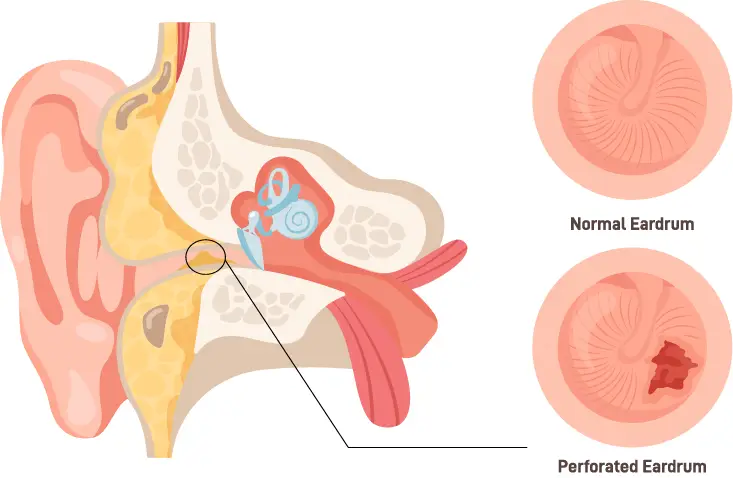- 200+ Tympanoplasties performed by Dr Avinash Borade
- Over 10000 patients treated
Want to know how tympanoplasty can help you
Call us Now
or Send us your details and we will contact you shortly
Tympanoplasty:
Tympanoplasty effectively removes infection from the eardrum and restores hearing ability. However, this surgical procedure requires proper before and after care to quickly cure the issue and ensure a safe and successful surgery.
Issues with ear and hearing are among the most common medical problems that more than 5% of the world’s population experience once. Issues with ears can range from mild to severe, which can easily be treated with some medication and rehabilitation services. But sometimes, infection can cause deafness, so the doctor may recommend surgery to cure the issue. However, tympanoplasty is the most well-known surgical procedure an ENT specialist may suggest to restore hearing and remove the disease from the ear. So, this guide will help you to learn detailed information about tympanoplasty and its benefits.

What is Tympanoplasty Surgery?
- Tympanoplasty is an essential surgical procedure for reconstructing tympanic membranes and ossicles in the ear.
It efficiently repairs an eardrum hole separating the middle ear from the outer ear. - Tympanic membrane: The tympanic membrane is a thin sheet that vibrates when hearing sound waves and helps transmit sound in the inner ear. However, infection can affect the thin membrane and its functioning, which leads to deafness and pain.
- Tympanoplasty surgery helps remove the disease from the middle ear, treat infection, restore hearing ability, and prevent reinfection so one can enjoy life without hassle.
Benefits of Tympanoplasty Surgery
Tympanoplasty surgery is very effective in treating different hearing loss issues.
- Tympanoplasty helps improve hearing, reduces the risk of infection, and relieves pain in the middle ear.
- Tympanoplasty removes infection or disease from the middle ear and helps in preventing the ear from future infections.
- It can also help restore hearing ability and allow proper hearing mechanisms. Moreover, tympanoplasty also prevents further damage to the middle ear.
Tympanoplasty Surgery Procedure under Dr. Avinash Borade
- Pre-Surgery Procedures
Our ENT specialist may recommend a proper pre-surgical procedure such as a physical examination, test, and medications, which helps in effective and efficient surgery.However, some of the standard procedures that a doctor may recommend before tympanoplasty are:
- Ear cleaning and microscopy: After physical examination, the doctor may clean the ear canal and inspect the tympanic membrane, which helps identify the right size and location of the perforation.
- Audiogram : The doctor may also perform an audiogram that helps in measuring hearing ability and knowing the severity of the condition.
- Pre-medication: Medication before surgery helps in preventing infections and their damage.
- Tympanoplasty Process
Tympanoplasty surgery is performed under general anesthesia, and it is done in different steps, which are as follows:
- One-day admission/daycare : The surgeon may suggest the patient be admitted to the hospital one day before the surgery so they can offer them proper care and examine the patient’s condition. Daycare in the hospital before surgery helps prepare patients for the surgery and eliminates possible risks.
- Post aural or endaural incision. Tympanoplasty takes 1 to 2 hours. During the surgery, the surgeon made an incision behind or above the ear to treat the infection. However, if the perforation is small, the surgeon may make an incision in the ear canal and create a flap in the eardrum to treat the issue. [Dr. Borade will be happy to explain the process in detail should you consider need tympanoplasty]
- Post-Surgery Care
A proper care routine after surgery is critical to avoid injuries and infection.
- You may need to wear a bandage for a few days to prevent exposure to water.
- ENT Surgeon may also suggest you avoid
- excessive straining
- or lifting heavy objects,
- take proper medication
- precautions to avoid having a cold or URTI,
- follow up with doctors with instructions, and get plenty of rest so you recover quickly.
- Causes of Hearing Loss?
Deafness can occur for various reasons, and some of the most common causes of hearing loss that require tympanoplasty are
- ossicular chain necrosis and tympanic membrane perforation.
- Tympanic membrane perforation is caused by infection or injury, which leads to improper vibration of the membrane and causes hearing loss.
- On the other hand, ossicular chain necrosis is a condition in which the bone in the middle ear dies and leads to improper transmission of sound waves in the ear.
- Both issues can easily be treated with tympanoplasty. Still, other reasons can cause hearing loss,
- such as ear infections,
- noise exposure,
- tumors,
- head injury,
- age-related issues, etc.
